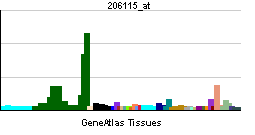EGR3
| Early growth response 3 | |||||||||||
|---|---|---|---|---|---|---|---|---|---|---|---|
| Identifiers | |||||||||||
| Symbols | EGR3 ; MGC138484; PILOT | ||||||||||
| External IDs | Template:OMIM5 Template:MGI HomoloGene: 37923 | ||||||||||
| |||||||||||
| RNA expression pattern | |||||||||||
 | |||||||||||
| More reference expression data | |||||||||||
| Orthologs | |||||||||||
| Template:GNF Ortholog box | |||||||||||
| Species | Human | Mouse | |||||||||
| Entrez | n/a | n/a | |||||||||
| Ensembl | n/a | n/a | |||||||||
| UniProt | n/a | n/a | |||||||||
| RefSeq (mRNA) | n/a | n/a | |||||||||
| RefSeq (protein) | n/a | n/a | |||||||||
| Location (UCSC) | n/a | n/a | |||||||||
| PubMed search | n/a | n/a | |||||||||
Early growth response 3, also known as EGR3, is a human gene.[1]
The gene encodes a transcriptional regulator that belongs to the EGR family of C2H2-type zinc-finger proteins. It is an immediate-early growth response gene which is induced by mitogenic stimulation. The protein encoded by this gene participates in the transcriptional regulation of genes in controling biological rhythm. It may also plays a role in muscle development.[1]
References
Further reading
- Yamada K, Gerber DJ, Iwayama Y; et al. (2007). "Genetic analysis of the calcineurin pathway identifies members of the EGR gene family, specifically EGR3, as potential susceptibility candidates in schizophrenia". Proc. Natl. Acad. Sci. U.S.A. 104 (8): 2815–20. doi:10.1073/pnas.0610765104. PMID 17360599.
- Gerhard DS, Wagner L, Feingold EA; et al. (2004). "The status, quality, and expansion of the NIH full-length cDNA project: the Mammalian Gene Collection (MGC)". Genome Res. 14 (10B): 2121–7. doi:10.1101/gr.2596504. PMID 15489334.
- Yoo YG, Lee MO (2004). "Hepatitis B virus X protein induces expression of Fas ligand gene through enhancing transcriptional activity of early growth response factor". J. Biol. Chem. 279 (35): 36242–9. doi:10.1074/jbc.M401290200. PMID 15173177.
- Inoue A, Omoto Y, Yamaguchi Y; et al. (2005). "Transcription factor EGR3 is involved in the estrogen-signaling pathway in breast cancer cells". J. Mol. Endocrinol. 32 (3): 649–61. PMID 15171706.
- Liu D, Jia H, Holmes DI; et al. (2004). "Vascular endothelial growth factor-regulated gene expression in endothelial cells: KDR-mediated induction of Egr3 and the related nuclear receptors Nur77, Nurr1, and Nor1". Arterioscler. Thromb. Vasc. Biol. 23 (11): 2002–7. doi:10.1161/01.ATV.0000098644.03153.6F. PMID 14525795.
- Strausberg RL, Feingold EA, Grouse LH; et al. (2003). "Generation and initial analysis of more than 15,000 full-length human and mouse cDNA sequences". Proc. Natl. Acad. Sci. U.S.A. 99 (26): 16899–903. doi:10.1073/pnas.242603899. PMID 12477932.
- Yang Y, Dong B, Mittelstadt PR; et al. (2002). "HIV Tat binds Egr proteins and enhances Egr-dependent transactivation of the Fas ligand promoter". J. Biol. Chem. 277 (22): 19482–7. doi:10.1074/jbc.M201687200. PMID 11909874.
- Tourtellotte WG, Milbrandt J (1998). "Sensory ataxia and muscle spindle agenesis in mice lacking the transcription factor Egr3". Nat. Genet. 20 (1): 87–91. doi:10.1038/1757. PMID 9731539.
- Morris ME, Viswanathan N, Kuhlman S; et al. (1998). "A screen for genes induced in the suprachiasmatic nucleus by light". Science. 279 (5356): 1544–7. PMID 9488654.
- Hillier LD, Lennon G, Becker M; et al. (1997). "Generation and analysis of 280,000 human expressed sequence tags". Genome Res. 6 (9): 807–28. PMID 8889549.
- Mages HW, Stamminger T, Rilke O; et al. (1993). "Expression of PILOT, a putative transcription factor, requires two signals and is cyclosporin A sensitive in T cells". Int. Immunol. 5 (1): 63–70. PMID 8443122.
- Patwardhan S, Gashler A, Siegel MG; et al. (1991). "EGR3, a novel member of the Egr family of genes encoding immediate-early transcription factors". Oncogene. 6 (6): 917–28. PMID 1906159.
External links
- EGR3+protein,+human at the US National Library of Medicine Medical Subject Headings (MeSH)
| This protein-related article is a stub. You can help Wikipedia by expanding it. |
This article incorporates text from the United States National Library of Medicine, which is in the public domain.